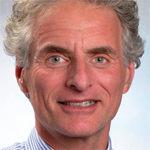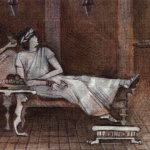Mysterious Ways
The juxtaposition of the old and the new was readily evident that busy Wednesday morning. My first patient, a 94-year-old gentleman, Hal, arrived with a precise request. His rheumatologist for the past 40 years had just retired, and he was searching for a doctor with expertise in the use of gold sodium aurothioglucose, the drug that had driven his rheumatoid arthritis (RA) into remission decades before.
Whether it was based on fact or superstition, we were taught that if gold induced a state of low disease activity, it should never be stopped. The lucky few patients who achieved remission would return monthly for their injections, ad infinitum.
Hal described the marvelous benefits of gold, and he was mystified as to why this “wonder drug” had become so difficult to procure. Although he located a pharmacy that sold an injectable gold salt product, it was of a different variety, gold sodium thiomalate (GST), a formulation that caused him great distress, with symptoms of nausea and flushing following each injection, reminiscent of the irksome nitritoid reaction, a well-recognized side effect of chrysotherapy that occurred in roughly 5% of patients taking GST.1
Hal’s physical findings were few; his joint exam findings were negligible; and his pale complexion belied his many decades of gold salt use, because there was no chrysiasis, the telltale slate-grey skin pigmentation that often identified the recipient of gold therapy to the knowledgeable eye.2
As I was meeting Hal, one of our fellows was busy disassembling a complicated tale from her new patient, Dawn, a woman about a quarter Hal’s age, whose lifelong juvenile idiopathic arthritis provided ample evidence of ongoing synovitis and prior joint damage. Over the years, the various synthetic and biologic disease-modifying drugs that stock our modern-day armamentarium had been prescribed, achieving scant success.
How odd to juxtapose the successful outcome observed in one patient who was prescribed an ancient, heavy-metal nostrum, whose mode of action in RA was poorly understood, with the failure in another patient of our newest, targeted therapies, whose constructs were based upon our sophisticated knowledge of modern-day immunology.
These anomalous outcomes serve as a reminder that medicine can still move in mysterious ways (with an homage to Bono and U2!).3 Fortunately, we are making great strides in disassembling both the innate and adaptive arms of the immune response, allowing a clearer insight into the complexities of the autoimmune responses. The accretion of knowledge that has dramatically transformed our clinical practice over the past 70-odd years can be traced to a sequence of revolutions in the clinical and basic sciences.
A Series of Revolutions
The first revolution occurred following the end of the first World War, about the time when rheumatology began organizing into a distinct specialty. Previously, clinicians with an interest in rheumatic disease tended to come from one of two fields: infectious diseases, because a commonly held belief at the time was the critical role that mycobacteria and bacteria played in the pathogenesis of chronic forms of arthritis and inflammation, and the field of physical medicine, in particular medical hydrology, a long-lost discipline that sought to incorporate the use of saunas, spas and whirlpools into clinical practice. What a life!.
In fact, some historians date the origins of organized rheumatology to a spring day in Paris, in April 1925 at the inaugural meeting of the International Society of Medical Hydrology, where Jan van Breeman, MD, a leading Dutch physician, offered a resolution calling for the appointment of an International Committee on Rheumatism. This resolution was the first step in the formation of the American Rheumatism Association (ARA), the forerunner of the ACR.4
The second revolution occurred following the second World War, when, in 1949, before a crowd of a few hundred doctors attending the ARA national meeting, Philip Hench, MD, of the Mayo Clinic, in Rochester, Minn., and his colleagues described the dramatic effects of cortisone in treating RA. Their painstaking research finally identified and isolated the elusive hormonal compound that served as the template for the production of the first corticosteroid drugs. This Nobel Prize-worthy discovery changed our specialty forever. Where would we be without corticosteroids?
The third revolution took place in the latter decades of the 20th century as clinicians gained a clearer understanding of immune-suppressive therapies and initiated more rational approaches to treat rheumatologic diseases that included the use of drugs, such as allopurinol, azathioprine, cyclophosphamide, immune intravenous gammaglobulin, methotrexate, mycophenolate and others, into our armamentarium.
The fourth revolution capitalized on the expanse of knowledge acquired in understanding the pathogenesis of autoimmunity and applied it to create a series of targeted therapeutics that have dramatically transformed our practice. It began with the unraveling of the immune cascade that led to the identification of TNF as a key target in the pathogenesis of inflammation in a host of autoimmune-mediated diseases.5 Subsequent research confirmed the pharmaco-immunologic relevance of several useful targets for commercialization, including interleukin (IL) 1, IL-6, IL-12, IL-17, IL-23, T cell costimulatory receptors, BLyS and CD-20. Rheumatology has moved far beyond our primeval roots in the sauna and the spa.
Our deeper understanding of inflammation’s role in health and disease has created some interesting offshoots. There has been intense interest in utilizing C-reactive protein (C-RP) as a marker for the metabolic syndrome and for cardiovascular disease. This led to the recent observation that canakinumab, a therapeutic monoclonal antibody targeting IL-1β that was developed to treat refractory gout and selected auto-inflammatory disorders, can significantly lower the rate of recurrent cardiovascular events in patients with a previous myocardial infarction and an elevated CRP.6 In a similar vein, the NIH-sponsored Cardiovascular Inflammation Reduction Trial is investigating whether weekly doses of methotrexate can reduce the incidence of cardiovascular events among adults with a history of a prior myocardial infarction and either type II diabetes or the metabolic syndrome.7 When it comes to the affairs of the heart, inflammation matters.
Some historians date the origins of organized rheumatology to a spring day in Paris, in April 1925 at the inaugural meeting of the International Society of Medical Hydrology, where Jan van Breeman, MD, a leading Dutch physician, offered a resolution calling for the appointment of an International Committee on Rheumatism.
Bringing the Bench to the Bedside
The acceleration of extraordinary advances being made in the fields of genomics, bioinformatics and molecular diagnostics defines the fifth revolution in rheumatology. The bench has finally arrived at the bedside. Clinicians and their patients can gain from these breakthroughs. Here is one recent example:
The recently defined COPA mutation is responsible for the development of a syndrome characterized by rheumatoid factor positive RA, interstitial lung disease with pulmonary hemorrhage and ANCA-positive vasculitis. This autosomal-dominant transmitted mutation, a 14-residue region of the WD40 domain of the ubiquitously expressed gene for COPA, encodes a resident chaperone protein in the endoplasmic reticulum. An aberration in the structure of this protein results in the development of a rheumatologic disorder that is virtually identical to RA with lung disease and in some patients, a systemic vasculitis.
A dear patient of mine was recently identified as having this mutation in her genome. She is a member of one of the five families with multiple individuals afflicted by pulmonary hemorrhage who were studied in the original report.8 Her physical exam, imaging studies and lab tests were all consistent with a classical presentation of RA. Her episode of acute pulmonary hemorrhage displayed all the appearances of a systemic vasculitis, including a positive ANCA antibody along with an active urinary sediment with a rising serum creatinine. She responded to treatment with intravenous cyclophosphamide, and over the ensuing years, her “RA” has been adequately controlled with a combination of drugs, although her pulmonary function continues to slowly decline.
Undoubtedly, the identification of these subsets of patients carrying unique genetic features will alter our understanding of what drives autoimmunity, and we can get even more precise in creating targeted therapies.
Another example of moving the bench to the clinic is the emerging use of various forms of molecular diagnostics in establishing diagnoses of rare or hard-to-diagnose conditions. You can’t call yourself a rheumatologist if you haven’t experienced the situation in which a patient has an array of abnormal findings yet a conclusive diagnosis remains elusive. Now, there are ways to move beyond this diagnostic roadblock. Consider the use of metagenomics deep sequencing (MDS) that was recently described in these pages.
MDS is an unbiased, hypothesis-free approach toward infectious disease diagnosis that leverages the remarkable efficiency of massively parallel sequencing technologies paired with concomitant advances in computational algorithms and processing speed that is required for the resulting large volumes of sequence data. It’s now possible to sequence all the nucleic acid in a patient sample, filter out all the human sequences and then rapidly query large public databases to identify the source of the nonhuman sequences present in the sample. It’s akin to searching massive databases for one exact phrase—the ultimate needle in a haystack.
This technology was recently put to great use by our Consult Service team in identifying the cause of a near catastrophic sterile endocarditis in a 53-year-old male with longstanding seronegative arthritis treated with methotrexate. Following his valve-replacement surgery, he became critically ill with an orchitis, myositis and severe ocular inflammation. Although myriad tissue cultures were frustratingly negative, the culprit responsible for his debilitating illness, Tropheryma whipplei, could not evade the massive searchlight cast by MDS. The team was awestruck by the discovery that his undiagnosed Whipple’s disease explained all his clinical findings. Imagine that!
Bringing the Bench to Jurassic Park
Several other research innovations will likely advance the promise of translational research into a clinical reality. Perhaps none is more promising than the gene-editing tool known as CRISPR that can remove snippets of a gene sequence that are deleterious to the host and replace them with corrected genetic material. Studies are underway to correct the genetic flaws responsible for Duchenne muscular dystrophy and common causes of infantile blindness. In fact, the actress Jennifer Lopez is the executive producer of an upcoming CRISPR-themed bio-crime drama on the NBC television network.9
Perhaps an even more eye-catching idea for CRISPR is the proposal put forward by one of the eminent researchers in this field, George Church, PhD, professor of genetics at Harvard Medical School in Boston. Dr. Church’s lab has been prolific in this area, but one of their projects is particularly stunning: since 2015, his group has been using CRISPR to resurrect the wooly mammoth and repopulate the northern Eurasian tundra with these animals to restore the tundra to an arctic grassland, preserving the earth’s permafrost and new world!
I hope Steven Spielberg can be persuaded to put this story to film. Unlike Jurassic Park, it won’t be a science fiction movie—it will be a documentary.
 Simon M. Helfgott, MD, is associate professor of medicine in the Division of Rheumatology, Immunology and Allergy at Harvard Medical School in Boston.
Simon M. Helfgott, MD, is associate professor of medicine in the Division of Rheumatology, Immunology and Allergy at Harvard Medical School in Boston.
Some Final Words

vectorfusionart / SHUTTERSTOCK.COM
Dear Readers,
This is it. After filing this, my 72nd Rheuminations column, it’s time to move on. It’s been a remarkably fulfilling and joyous experience for me. I was handed the rare opportunity to write about “stuff,” topics of interest to our community of rheumatologists, without any impositions. I am truly grateful to the ACR and its wonderful staff, especially Joan Roth and Rachel Whittaker, the members of the Communications and Marketing Committee, and our presidents, past and present. Together, we have witnessed the continued growth of The Rheumatologist, which has risen to become the most read periodical in rheumatology today.
A special thanks to our publisher, Lisa Dionne Lento, and her capable team at John Wiley and Sons, including our associate editor, Donna Petrozzello, who have worked hard to keep the printing presses going and ensuring that each monthly broadsheet gets delivered to your real or virtual mailbox.
Thanks to Natasha Yetman and Cindy Devone-Pacheco, who organize the content of eNewsRheum, our weekly enewsletter highlighting some of the fast-breaking stories, and ACR@Work, the enewsletter highlighting legislative and advocacy issues.
What would our periodical be without the wonderful artwork and illustrations selected by Lil Estep, who has served in this capacity since the inception of The Rheumatologist. Her astute eye for art and graphic design ensures that whatever the story is about, it will look and read even better with her added touches.
To tell the truth, when I assumed the role of physician editor I had no idea about what I was actually getting into. I recognized the daunting task of maintaining the high standards established by our inaugural physician editor, David Pisetsky MD, PhD, and Dawn Antoline, the editor at Wiley, would pose some challenges. Thankfully, I could rely on their wisdom, guidance and support to get me established in my position and allow for a smooth transition.
Working alongside Rick Brasington, MD, and Maura Iversen, DPT, MPH, as my co-editors has been a real treat. Maura has an encyclopedic knowledge of all things musculoskeletal—it’s always great to google her brain. She has a worldwide set of connections that made it easy to find experts in every field of study. Rick is a true Renaissance man, a scholar, a gifted teacher and the premier rheumatologist–beekeeper in the U.S.! Never shy to offer his opinion, he was always available to provide his wise counsel.
What can I say about Keri Losavio, our editor? She is truly the perfect person to work with. Amazingly efficient, thoughtful and organized. Despite the three-hour time zone difference that separated us, our email interchanges seemed more like texting—they were answered within seconds after being sent. Keri can juggle dozens of issues at once and never drop an item or forget a key fact. Her editing skills are impeccable—she is the grammar queen! I will miss our regular chatter and daily interchanges.
A special thank you to my wonderful wife, Linda. My lifetime partner who keeps things in place; my great advisor who helped mold my pieces together. This usually took place on our early morning 10 km runs along the Boston marathon’s Heartbreak Hill, near where we live. Releasing brain endorphins seems to be the best way to release creativity, and Linda knew how to get me to do this best. She was my N of 1 audience who critiqued my essays before I sent them anywhere. We should all be so fortunate when choosing a mate! A shout-out to my three wonderful kids, Seth in San Francisco, Gabrielle in Denver and Katie in Seattle, whose long-distance cheerleading could always be relied upon.
Finally, it is my distinct pleasure to welcome our great colleague, Phil Seo, MD, MHS, as your new physician editor. A talented educator, he serves as the Rheumatology Fellowship Program director at Johns Hopkins University School of Medicine in Baltimore. Phil is an exceptional clinical scholar with deep interests in vasculitis and other rheumatologic disorders. He has expertise in medical writing and editing, and I look forward to seeing his plans unfold in the coming issues of The Rheumatologist.
With that I bid you all a fond adieu!
References
- Arthur AB, Klinkhoff A, Teufel A. Nitritoid reactions: Case reports, review, and recommendations for management. J Rheumatol. 2001 Oct;28(10):2209–2212.
- Schmidt OEL. Chrysiasis. Arch Derm Syphilol. 1941;44(3):446–452.
- U2. Mysterious ways.
- Stecher RM. The American Rheumatology Association—Its origins, development and maturity. Arthritis Rheum. 1958;1(1):4–19.
- Croft M. The role of TNF superfamily members in T-cell function and diseases. Nat Rev Immunol. 2009 Apr;9(4):271–285.
- Ridker PM, Everett BM, Thuren T, et al. Antiinflammatory therapy with canakinumab for atherosclerotic disease. N Engl J Med. 2017 Sep 21;377(12):1119–1131.
- National Institutes of Health. NIH launches trial to evaluate anti-inflammatory treatment for preventing heart attacks, strokes, and cardiovascular deaths [press release]. 2012 Aug 22.
- Watkin LB, Jessen B, Wiszniewski W, et al. COPA mutations impair ER-Golgi transport and cause hereditary autoimmune-mediated lung disease and arthritis. Nat Genet. 2015 Jun;47(6):654–660.
- Beyond just promise, CRISPR is delivering in the lab today. The Conversation. 2017 May 17.
- Epstein SF, Wang ML. Bring back the mammoth. Harvard Crimson. 2017 Oct 19.

